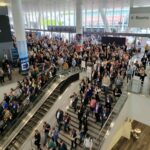
Is It Time for a New Learning Format?
While panel presentations, lectures, and small-group discussions are staples at conferences, associations that switch things up and introduce new formats can better engage attendees and appeal to different learning styles.
Some attendees love panel discussions, while others loathe them. And while there are people who want to interact and do table exercises with colleagues during sessions, there are just as many who prefer to sit, listen, and take notes.
To manage these different learning preferences and expectations, associations tend to offer a variety of session formats throughout their conferences. Here’s a look at three new formats and sessions introduced at association meetings over the past year or so:
Show the human side. Sessions offered at the American Society of Clinical Oncology’s Annual Meeting typically feature these three elements: slides, podiums, and data—lots of data. And that’s not surprising, given that one of the main goals of the conference is for physicians, scientists, and researchers to share the latest innovations in cancer care treatment. But, at its June 2018 meeting, ASCO tried something new when it introduced a session format called ASCO Voices.
Each presentation had to be seven minutes or less. It could not include slides, and speakers could not stand behind a podium. These talks were just about a story and a stage, featuring five voices in oncology who discussed everything from big ideas to personal passions. Jamie Von Roenn, MD, an oncologist and ASCO’s vice president of education, who came up with the idea, told Medscape Medical News the session format allowed the conference to get away from the dulling effect of data and let oncologists show their “human selves” and connect with one another on a deeper level.
Add new perspectives. The National Council of Public History (NCPH) introduced a format called Community Viewpoints [PDF] at its May 2018 Annual Meeting. Previously, sessions had only included the voices of public historians (museum professionals, archivists, historic preservationists, policy advisers, etc.) and other industry experts discussing the goals, execution, and outcomes of their projects.
But this year, as way to foster more inclusivity, Community Viewpoints sessions included the perspective of community members and residents who were affected or served by projects managed by NCPH members. According to the website, it was a “way to bring new voices to NCPH” and to provide firsthand accounts of how members’ work affects people’s day-to-day lives.
Share best practices. The Forum on Education Abroad had heard from its annual conference attendees that they wanted more opportunities to share and exchange best practices with one another. As a result, it introduced Best Practice Laboratories at its March 2018 conference.
Here’s how it worked: Each presenter made a brief, one-minute opening remark and then moved to an individual station with a handout that illustrated his or her best practice. After that, attendees circulated freely around the room, engaging in one-on-one or small-group discussions with presenters. Ideas shared at this year’s meeting included advising students with disabilities about studying abroad and implementing ideas through data-driven decisions.
Have you introduced new session formats at recent conferences? Tell us how they worked out in the comments.
(PeopleImages/E+/Getty Images Plus)






Comments